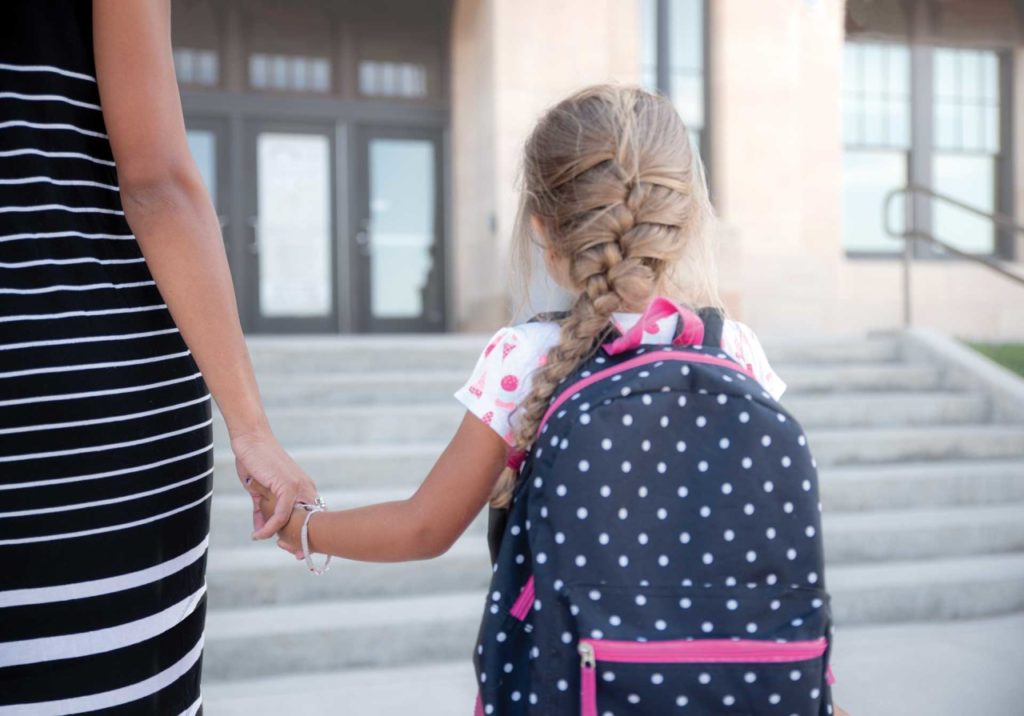There are steps you can take to prepare your kids for a new school routine to help make the transition an easier one—for both of you!
Change is exciting, but it can also be uncomfortable and a little bit scary. One of the biggest sources of tension children face is transitioning to a new grade level, especially if they are making the jump from elementary to middle school, or moving from middle to high school.
KINDERGARTEN to FIRST GRADE
The first major transition in a child’s academic life involves making the leap from kindergarten to first grade. Gone are nap times and half-days; your child must get used to a more structured environment that emphasizes learning over playing, and will be attending school all day long. They may have their own desk instead of a table and cubbyholes, and might be eating lunch away from home for the first time in their young lives. These experiences are both exciting and intimidating; the following tips will help prepare your child for this new chapter in his or her life.
Visit the school with your child ahead of time. This will help them become familiar with their classroom and other new surroundings, as well as the route there, so they’ll feel less overwhelmed on the first day. If there is a formal orientation, they’ll have an opportunity to meet their teacher and maybe even ride the bus.
Always speak positively about going to school. Emphasize the fact that they’ll be learning to read and write soon. Kids love to feel grown up! Your excitement and enthusiasm should prove contagious.
Establish a routine before the first day. Make sure your child goes to bed early and wakes up on time. Encourage them to choose an outfit, have their backpack ready, and pack a lunch each evening before bed.
Be prepared for a little fussiness at first. Your child will be experiencing a lot of new things and may lash out or cry for a few weeks. Practice patience and leniency; before long, first grade will become second nature!
ELEMENTARY to MIDDLE SCHOOL
Middle school means a bigger campus, multiple teachers and classrooms, and increased responsibilities. The combination of early adolescence and new experiences, such as lockers for storage and moving from the highest grade to the lowest, can make even the best student feel a bit overwhelmed. The following tips will help your child ease into middle school.
Attend an orientation or campus tour with your child. This will give them a preview of the campus layout and they might have a chance to try out their combination locker—always an area of concern for kids used to remaining in one classroom all day.
Obtain a copy of the student handbook and review the different rules and requirements with your child so they have a thorough understanding of what is expected of them.
Check online for a map of the school and have them memorize the location of their classes, locker, lunchroom, and bus stop once your child receives their class schedule.
Teach your child to be their own advocate. Whether they are having trouble with bullies, have questions about homework assignments, or could benefit from extra tutoring, let them know that middle school is the time to embrace their independence.
MIDDLE SCHOOL to HIGH SCHOOL
The transition to high school brings many of the same concerns as moving to middle school, but on an even larger scale. There are more students, more classes, a bigger campus, and a whole new set of fears. Kids worry about making new friends, tackling a heavier workload, participating in extracurricular activities, and choosing the right electives—all while dealing with the demands of adolescence. It’s an exciting and scary time, but the following tips will help make it less stressful.
Now is the time to establish routines and encourage good work habits. There’s a lot to balance in high school; classes, homework, after-school activities, social life, and jobs all compete for your teen’s attention. Set priorities—a consistent schedule is a must for ensuring homework is completed and extracurricular commitments are honored.
Encourage independence. The high school years are a bridge to adulthood and a time for your child to learn how to confront challenges on their own. This doesn’t mean disappearing completely from the picture, however—just take a step back.
Keep the lines of communication open. Check in with your child periodically to learn how their classes are going and whether they need help with anything. Make it a priority to eat dinner together as a family at least a couple of times a week.
WORDS: MARK PETRUSKA
PHOTOS: JESSE BROWN NELSON



